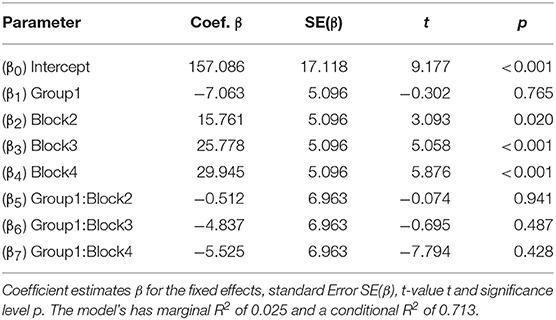Absence of Alpha-tACS Aftereffects in Darkness Reveals Importance of Taking Derivations of Stimulation Frequency and Individual Alpha Variability Into Account
- 1Experimental Psychology Lab, Department of Psychology, European Medical School, Cluster for Excellence “Hearing for all”, Carl von Ossietzky University, Oldenburg, Germany
- 2Research Center Neurosensory Science, Carl von Ossietzky University, Oldenburg, Germany
by Stecher, H. I., and Herrmann, C. S. (2018). Front. Psychol. 9:984. doi: 10.3389/fpsyg.2018.00984
In the original article, there was a mistake in Table 2 as published. The last parameter in the table is wrongly designated as “(β8) Group1:Block4” instead of “(β7) Group1:Block4.”
The corrected Table 2 appears below.
In the results section, two decimal points are missing: the F-value of time x group interaction: F3, 75 = 578, is actually F3, 75 = 1.578. The p-value for T1: p = 862 is actually p = 0.862. In the same section in equations 1&2: the coefficient β4 is wrongly used twice: “β4 group1*block2,” should be “β5 group1*block2” and all subsequent “βs” numbered accordingly. A correction has been made to EEG Results, Exploratory Analysis, Paragraph 1 and Paragraph 2 and equation 1&2:
Due to unexplained discrepancies between published reports and the results of our standard analysis approach, we performed an additional analysis to uncover confounding factors. Previous tACS studies in the α-range show that the power-enhancement relative to sham correlated with the negative mismatch between the stimulated frequency and true IAF (Vossen et al., 2015). Additionally it could be shown, that the inclusion of such a mismatch as a factor explains observed variance when modeling power-enhancement (Stecher et al., 2017). The large variance in the baseline α-power (see Figures 2A–C, albeit not significantly different between groups), encouraged us to test, whether baseline-power might influence the capacity for post-stimulation enhancement. For this reason, we included both the factors frequency mismatch as well as baseline power as covariates to a repeated measure ANCOVA. This did not lead to different results in the case of the decreasing sequence condition compared to sham, revealing no significant main effect of time [time (F1, 75 = 1.767, p = 0.180, η2 = 0.066)], no significant effects of the factor group (F1, 25 = 0.199, p = 0.659, η2 = 0.008), or the interaction time × group (F3, 75 = 0.578, p = 0.570, η2 = 0.023). In the case of the increasing sequence, however, the inclusion of the covariates not only revealed the above-mentioned significant main effect of time (F1, 75 = 6.471, p = 0.018, η2 = 0.206), but also a significant interaction of time × group (F3, 75 = 4.134, p = 0.009, η2 = 0.142). The interaction of time x basepower showed a trend (F3, 75 = 2.703, p = 0.051, η2 = 0.098), while the factor group (F1, 25 = 0.931, p = 0.344, η2 = 0.036) and the interaction time x mismatch did not reach significance (F3, 75 = 1.478, p = 0.227, η2 = 0.056).
However, the resolution of the interaction time x group, employing post-hoc one-way ANCOVAs for every timepoint between groups, did not yield any significant differences between groups at any timepoint (T1 group: F1, 25 = 0.031, p = 0.862, η2 = 0.001; T2 group: F1, 25 = 0.148, p = 0.704, η2 = 0.006; T3 group: F1, 25 = 0.1966, p = 0.173, η2 = 0.073; T4 group: F1, 25 = 2.452, p = 0.130, η2 = 0.89; all p-values uncorrected).
The authors apologize for these errors and state that this does not change the scientific conclusions of the article in any way.
The original article has been updated.
Conflict of Interest Statement
CSH has filed a patent application on brain stimulation and received honoraria as editor from Elsevier Publishers, Amsterdam.
The remaining author declares that the research was conducted in the absence of any commercial or financial relationships that could be construed as a potential conflict of interest.
References
Stecher, H. I., Pollok, T. M., Strüber, D., Sobotka, F., and Herrmann, C. S. (2017). Ten minutes of α-tACS and ambient illumination independently modulate EEG α-power. Front. Hum. Neurosci. 11:257. doi: 10.3389/fnhum.2017.00257
Keywords: transcranial alternating current stimulation (tACS), EEG, aftereffect, alpha oscillations, replication, tES reliability
Citation: Stecher HI and Herrmann CS (2018) Corrigendum: Absence of Alpha-tACS Aftereffects in Darkness Reveals Importance of Taking Derivations of Stimulation Frequency and Individual Alpha Variability Into Account. Front. Psychol. 9:1769. doi: 10.3389/fpsyg.2018.01769
Received: 21 August 2018; Accepted: 03 September 2018;
Published: 19 September 2018.
Copyright © 2018 Stecher and Herrmann. This is an open-access article distributed under the terms of the Creative Commons Attribution License (CC BY). The use, distribution or reproduction in other forums is permitted, provided the original author(s) and the copyright owner(s) are credited and that the original publication in this journal is cited, in accordance with accepted academic practice. No use, distribution or reproduction is permitted which does not comply with these terms.
*Correspondence: Christoph S. Herrmann, christoph.herrmann@uni-oldenburg.de
 Heiko I. Stecher
Heiko I. Stecher Christoph S. Herrmann
Christoph S. Herrmann